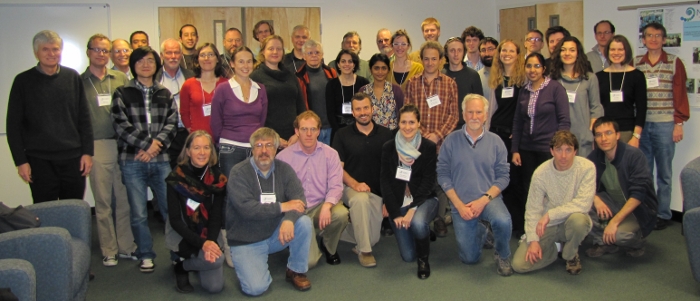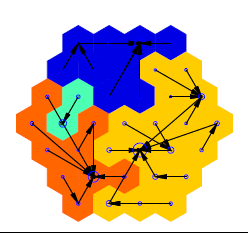| Description | Participants | Agenda | Summary | Products |
|---|
NIMBioS-NESCent Investigative Workshop
Modeling Social Complexity

Topic: Towards a formal theory for the evolution of human social complexity
Meeting dates: February 6-8, 2012
Organizers:
Peter Turchin, Dept. of Ecology and Evolutionary Biology, Univ. of Connecticut, Storrs
Laura Fortunato, Santa Fe Institute, Santa Fe, NM
Sergey Gavrilets, Dept. of Ecology and Evolutionary Biology, Dept. of Mathematics, Univ. of Tennessee, Knoxville
Objectives. The aim of this workshop, jointly sponsored by NIMBioS and NESCent, is to bring together a diverse group of modelers with anthropologists, archaeologists, and other social scientists to (i) synthesize the state of knowledge in formal models of the evolution of social complexity, (ii) identify unresolved issues, and (iii) set an agenda for future collaborative work. The workshop will be organized around the following general themes: What theories and data are available? What are the empirical patterns that cannot be explained by the existing theories and data? How can we adapt existing models to make full use of the available data? What kinds of data are needed to better inform the models? What new modeling techniques and methods need to be developed?
The great majority of humans today live in complex societies, which can exist only on a basis of extensive cooperation among large numbers of individuals. Ultrasociality, the ability of humans to cooperate in large groups of genetically unrelated individuals, presents a puzzle to both evolutionary and social theory. Its emergence likely involved the evolution of cooperation in small groups, characterized by an egalitarian social structure, followed by a reversal of this trend starting around 5–10 kya, with the rise of the first nonegalitarian complex societies. Theories to explain how complex societies evolved span the biological, social, and historical sciences, but they largely rely on verbal reasoning: until recently, formal models have focused on the evolution of cooperation in small groups, while the transition from small- to large-scale societies has been mostly neglected.
We aim to achieve a true dialogue between modelers and empiricists. Fortunately, comparative data are readily available in the anthropological literature to inform the model-building process and for empirical testing of model predictions. In modelling the transition from small- to large-scale societies, and the concomitant development of hierarchical social organization, these data can be used to extract clusters of factors that co-vary with degree of political integration, and which may therefore have driven this transition. The processes inferred from the synchronic data in cross-cultural samples can then be tested against the diachronic data in archaeological databases. Additionally, complete sequences of archaeological data for selected world regions can be used to investigate the extent to which the patterns and processes inferred from these worldwide samples generalize through time and space. The future development of this field need not be limited to existing databases: one of the workshop goals is to motivate archaeologists and anthropologists to develop additional regional sequences.
One of the immediate goals of the workshop will be publication of a special issue in a professional journal to be determined, which will include several reviews written by workshop participants. It is likely that a number of new research collaborations will be established at the workshop; additionally, we hope to identify an area at the interface of modelling and data analysis that would be most promising to tackle within a NIMBioS Working Group.
Evaluation report (PDF)

Summary. The workshop started with a brief discussion of general goals and some conceptual issues, followed by five half-day sessions, each dealing with one of the general themes specified in the proposal. Session 1 focused on general patterns in the transition from small- to large-scale social complexity. Specific topics addressed concerned (i) the growth in the information-processing capacity of human beings, both individually and in groups, (ii) the driving forces and constraints in the evolution archaic states, and (iii) patterns of increasing social complexity in Neolithic societies. Session 2 dealt with general theories of growth of social complexity. Presentations focused on the roles of warfare, bureaucracy, on the applicability of population ecology methods, and on theoretical explanations of cyclicity in the evolution of societies. Session 3 summarized a variety of mathematical modeling techniques used for studying the evolution of social complexity. It also included several presentations with novel modeling developments focusing on the emergence of leadership, evolution of languages, cooperation and warfare. Session 4 focused on the data available to inform theoretical models of the emergence of human social complexity and test their predictions . Two of the presentations related to available cross-cultural archaeological, historical, and ethnographic data; the other three related to data from field-based projects with small-scale populations in Bolivia, Kenya, and India. Session 5 discussed possible approaches for merging dynamic and statistical modeling with data. It also summarized recent theories emphasizing environmental effects and multi-level selection. Each session ended with a general discussion. The participants identified several promising avenues for future work, both modeling and data-base oriented. After the conclusion of the workshop some participants took part in a public debate on the role of warfare in the evolution of early social complexity, which generated a lot of interest on campus.
Related Links
Project Researchers participate in NIMBioS Workshop. 20 February 2012
Products
Publications
Gavrilets S, Fortunato L. 2014. A solution to the collective action problem in between-group conflict with within-group inequality. Nature Communications, 5: 3526. [Online]
Mesterton-Gibbons M, Heap SM. 2014. Variation between self- and mutual assessment in animal contests. American Naturalist, 183(2): 199-213. [Online]
Mesterton-Gibbons M, Sherratt TN. 2014. Bourgeois versus anti-Bourgeois: a model of infinite regress. Animal Behaviour, 89: 171-183. [Online]
Mesterton-Gibbons M, Karabiyik T, Sherratt TN. 2014. The iterated Hawk-Dove game revisited: The effect of ownership uncertainty on Bourgeois as a pure convention. Dynamic Games and Application, 4(4): 407-431. [Online]
Turchin P, Currie T, Turner EAL, Gavrilets S. 2014. Reply to Thomas: Diffusion of military technologies is a plausible explanation for the evolution of social complexity, 1500 BCE-AD 1500. Proceedings of the National Academy of Sciences, 111(4): E415. [Online]
Turchin P, Currie TE, Turner EAL, Gavrilets S. 2013. War, space, and the evolution of Old World complex societies. Proceedings of the National Academy of Sciences, 110(41): 16384-16389. [Online]
Presentations
Currie T. 16 April 2013. War and space: Simulating the evolution of old world complex societies. NIMBioS Seminar Series, NIMBioS, University of Tennessee, Knoxville, TN. [Online]
NIMBioS Investigative Workshops focus on broad topics or a set of related topics, summarizing/synthesizing the state of the art and identifying future directions. Workshops have up to 35 participants. Organizers and key invited researchers make up half the participants; the remaining participants are filled through open application from the scientific community. Open applicants selected to attend are notified by NIMBioS within two weeks of the application deadline. Investigative Workshops have the potential for leading to one or more future Working Groups. Individuals with a strong interest in the topic, including post-docs and graduate students, are encouraged to apply. If needed, NIMBioS can provide support (travel, meals, lodging) for Workshop attendees, whether from a non-profit or for-profit organization.
A goal of NIMBioS is to enhance the cadre of researchers capable of interdisciplinary efforts across mathematics and biology. As part of this goal, NIMBioS is committed to promoting diversity in all its activities. Diversity is considered in all its aspects, social and scientific, including gender, ethnicity, scientific field, career stage, geography and type of home institution. Questions regarding diversity issues should be directed to diversity@nimbios.org. You can read more about our Diversity Plan on our NIMBioS Policies web page. The NIMBioS building is fully handicapped accessible.
NIMBioS
1122 Volunteer Blvd., Suite 106
University of Tennessee
Knoxville,
TN 37996-3410
PH: (865) 974-9334
FAX: (865) 974-9461
Contact NIMBioS


